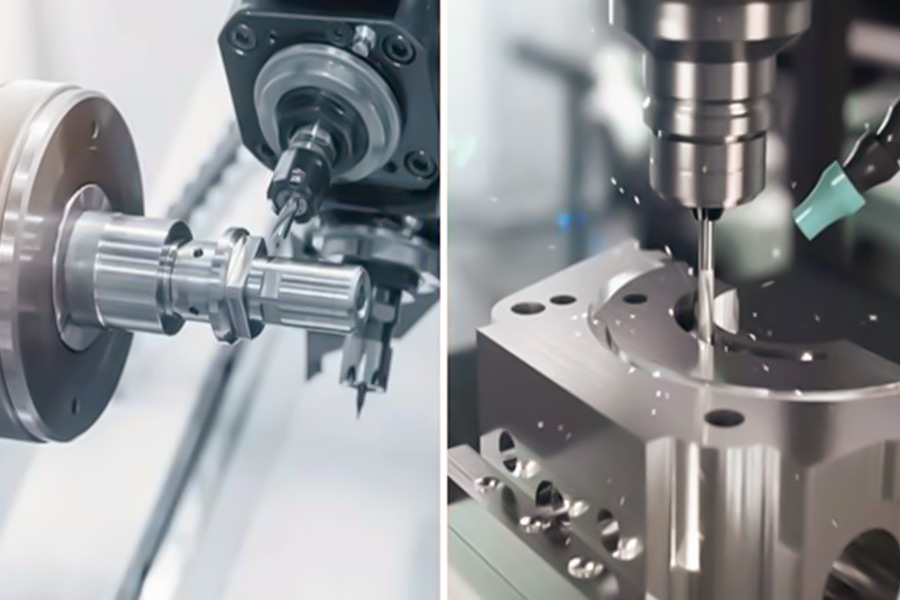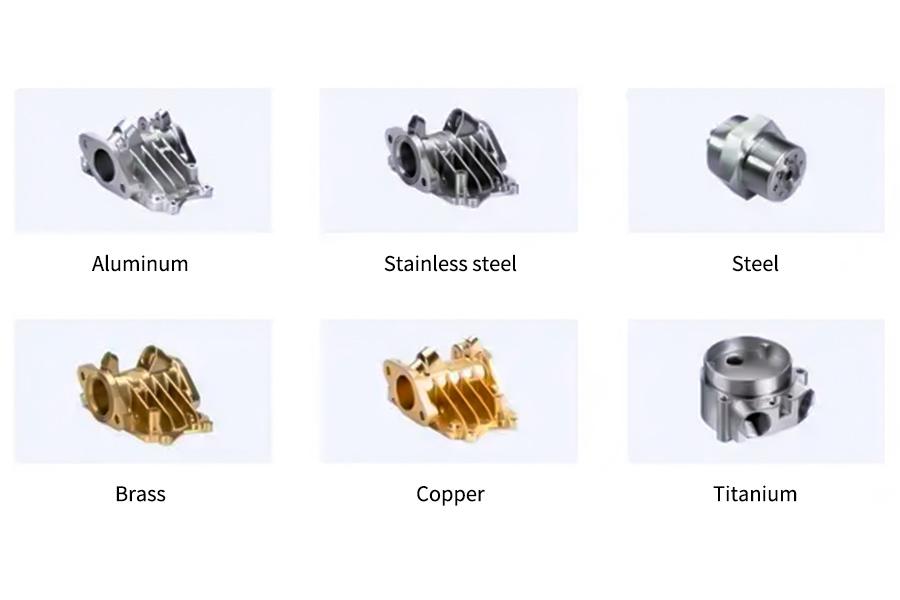With the rapid advancement of modern manufacturing, computer-controlled CNC (CNC) processing technology has gradually become a core component of highly precise and efficient automated processing technology. CNC machining technology is controlled by computer programs, allowing machine tools to operate automatically and capable of processing various materials with high precision. This technology has been widely used in many fields such as aerospace, automobile production, medical equipment and mold design.What materials are used in CNC machining?This article aims to explore this topic in depth and demonstrate the diversity ofCNC machiningtechnologyand its wide range of application scenarios.
What is CNC Machining?
CNC (computer numerical control) machining is a manufacturing process that uses computer-controlled machines to remove material from a workpiece and shape it into the desired shape. In short, it is an advanced process method that uses digital information to control machine tools to achieve parts processing. It breaks the limitations of traditional processing methods, perfectly integrates human wisdom and the power of machines, and realizes automation, intelligence and precision in the processing process. In this era of information explosion and rapid technological changes,cnc-machiningis not only an important cornerstone of Industry 4.0, but also a bridge connecting the past and the future, tradition and innovation.

What Materials Are Used in CNC Machining?
There are various types of materials commonly used in CNC machining, covering a variety of materials with different properties to meet the needs of different industries and fields. Here are some commonly usedCNC material lists:
1.Metal materials
Metal materials are one of the most common and widely used materials in CNC machining. They have high strength, good corrosion resistance and thermal conductivity, and can meet various complex and precise processing needs. Common metal materials include:
| Material | Feature |
| Aluminum | Offers excellent machinability, high strength-to-weight ratio, and superior corrosion resistance, making it perfect for lightweight, durable machined parts. |
| Stainless steel | Stainless steel offers superior corrosion resistance, high strength, excellent toughness and ease of fabrication, ideal for demanding machining operations. |
| Copper | Copper displays excellent thermal conductivity, electrical conductivity and plasticity. It is also highly ductile, corrosion resistant and can be easily welded. |
| Titanium | Titanium It’s a metal with excellent strength-to-weight ratio, low thermal expansion, high corrosion resistance; sterilizable and biocompatible for machining. |
| Brass | Brass has desirable properties for a number of applications. It is low friction, has excellent electrical conductivity and has a golden (brass) appearance. |
2.plastic material
Plastic is also a very popular choice for CNC machining due to its wide selection, relatively low prices, and significantly faster machining times required. The following are some commonCNC plastic materials:
- ABS:It has good processing performance and mechanical strength, and is often used in electronic product casings, automobile parts, etc.
- Polycarbonate (PC):It has high strength, high transparency and good heat resistance. It is often used to make optical components, transparent parts, etc.
- Nylon (PA):wear-resistant, oil-resistant, and water-resistant, often used to make gears, bearings, etc. Polypropylene (PP): Due to its low density, corrosion resistance, and ease of processing, polypropylene is widely used in the manufacture of containers such as cups, basins, and buckets, as well as the casings of electronic products.
- Polyvinyl chloride (PVC):PVC has good chemical resistance and electrical insulation properties and is suitable for a variety of industrial fields.
- Polytetrafluoroethylene (PTFE):PTFE is often used to manufacture seals, pipes, etc. due to its excellent high temperature resistance and chemical corrosion resistance.
- Polyethylene (PE):PE is a commonly used plastic material with good flexibility and impact resistance. It is widely used in packaging, agriculture and other fields.
3.wood
As a traditional material, wood is also widely used in CNC processing. CommonCNC material woodincludes walnut, cherry, oak, pine, etc. These woods have the characteristics of strong texture, good processability, and environmental protection, and are suitable for manufacturing furniture, architectural decoration, etc. Walnut is known for its beautiful texture and rich color, and is especially suitable for manufacturing high-end furniture.
How Do Different Materials Perform in CNC Machining?
metal material
Metal materials are common processing objects in CNC machining, and their processing performance is significantly affected by the hardness, strength, thermal conductivity and other factors of the material.
- Hardness and strength:The hardness and strength of metallic materials directly affect cutting forces, cutting speed and tool mortality. Heavy metal materials require a large cutting force during cutting, and the cutting speed needs to be reduced accordingly. The cutting tool will tire out too quickly.
- Thermal conductivity:Good thermal conductivity helps cooling and lowers the temperature of the cutting area, thereby reducing tool wear and improving processing quality.
- Processing efficiency and accuracy:The processing accuracy and automation features of CNC machining centers significantly improve the processing efficiency of metal materials, while ensuring processing accuracy and product consistency.
plastic material
CNC plastic materialhas good plasticity and toughness, but attention must be paid to the sharpness of the tool and the processing speed during processing to avoid melting and deformation. Large chips are usually produced during plastic processing, and the chip removal system needs to be properly designed.
Wood
When processingCNC material wood, attention must be paid to controlling the cutting parameters to avoid excessive damage to the structure of the wood. The fiber direction and density of wood have a great influence on cutting force, cutting temperature and surface quality.

Why Does CNC Machining Rely on Digital Instructions?
CNC machining relies on digital instructions calledCNC technology or more specifically computer numerical control technology, CNC machining relies on digital instructions or G-codes, which direct the machine on how to cut, drill, or shape the material. These digital files are generated from CAD models and allow for precise, repeatable processes.
The reasons why CNC machining relies on digital instructions mainly include high-precision control, convenient programming and operation, easy automation and intelligence, improved processing efficiency and stability, and easy troubleshooting and maintenance. These advantages make CNC machining occupy an important position in modern manufacturing and promote the rapid development of manufacturing.
What Are the Different Machining Processes for These Materials?
1.Grinding Machining
Grinding machiningis a processing method that uses abrasive tools (such as grinding wheels, whetstones, etc.) to grind the surface of the workpiece. The basic principle is to remove material on the surface of the workpiece through friction, scoring and scraping between the grinding tool and the surface of the workpiece to achieve the required size, shape and surface quality.
Grinding machining is widely used in machinery manufacturing, especially where high precision and high surface quality are required. It can process internal and external cylindrical surfaces, conical surfaces and flat surfaces of various workpieces, as well as special and complex forming surfaces such as threads, gears and splines. In addition, grinding can also process materials that are difficult to process with other machine tools, such as hardened steel, carbide, glass, ceramics, etc.
2.Lathe Machining
The basic principle oflathe machining is to use lathe equipment to remove excess material from the workpiece by rotating the workpiece and making it move relative to a fixed or moving cutting tool (such as a turning tool) to obtain the required shape, size and surface quality. parts or workpieces. Lathe machining can complete a variety of processing tasks, including but not limited to outer circle processing, inner circle processing (such as boring), end face processing, grooving, cutting off, forming surface processing, etc.
3.Milling Machining
Milling is the process of cutting materialfrom a workpiece using a rotating tool to create the desired shape and size. The selection of cutting tools and the setting of processing parameters have a significant impact on the processing effect. Generally speaking, high-speed steel tools are suitable for milling most metallic materials, while carbide tools are suitable for harder materials. In addition, the settings of parameters such as cutting speed, feed amount and cutting depth also need to be reasonably selected based on specific materials and processing requirements.
Milling Machiningis suitable for workpieces of various materials and shapes, including flat surfaces, grooves, spiral surfaces, tooth surfaces, formed surfaces and outer circles, etc. In mass production, in addition to processing long and narrow planes,mill machining can almost replace planing and become a common method for processing planes, grooves and formed surfaces.
What Materials Are Best Suited for CNC Milling vs. CNC Turning?
Compared withmachining lathe,mill machininghas certain flexibility and versatility in material processing. CNC milling is particularly suitable for processing a variety of materials, including but not limited to the following categories:
Aluminum:Because of its good machining performance and corrosion resistance, it is very suitable formill machining. Commonly used in the production of aircraft parts, building materials, medical components, etc.
Plastics: Plastics are non-metallic materials commonly used inmill machining. They are lightweight, corrosion-resistant, and can be molded into complex shapes. Plastics are widely used in industries such as automotive, medical and consumer products.
Ceramics: Ceramic materials are used inmill machiningbecause of their hardness, heat resistance, and electrical insulation properties. They are commonly used in industries such as aerospace, automotive and medical.
Wood and plywood: These materials are easy to cut and shape, so they are also commonly used formill machining. They are widely used in industries such as furniture manufacturing and construction.
Glass: Glass material is used inmill machiningdue to its transparency, heat resistance and electrical insulation properties, especially in fields such as electronics, automotive and medical.

Why Material Choice Matters in CNC Machining?
Performance
Choosing the right material affects the durability, accuracy and functionality of your part. For example, the physical properties of materials (strength, hardness, toughness, thermal expansion coefficient, etc.) directly affect the cutting force and cutting temperature during processing, as well as the dimensional accuracy and surface quality of the processed products. The processing properties of materials include machinability, weldability, forgeability, etc., which directly affect the ease and efficiency of the processing process.
cost
The procurement costs of different materials vary greatly. Choosing the right materials can reduce material costs while ensuring product performance. Materials that are easy to process can reduce tool wear, reduce processing time, and improve processing efficiency, thereby reducing processing costs. In addition, material recycling rates and waste disposal costs are also factors to consider. It is also necessary to consider the long-term use costs of materials, including maintenance costs, replacement costs, and loss of production due to material problems.
Application
Different products have different performance requirements for materials. For example, the aerospace field has strict requirements on the strength, weight and temperature resistance of materials, while medical devices pay more attention to the biocompatibility and corrosion resistance of materials. Therefore, the choice of materials must be based on the specific performance requirements of the product.
FAQs
1.What are the common materials used in CNC machining?
Metals (aluminum, brass, stainless steel, copper,and titanium), plastics (ABS, PMMA, PC, POM, PCGF30, PA, PC+ABS, PAGF30, PPGF30, PP, PTFE, PEI, PS, PPS, PE, PPSU, PET, PEEK, LDPE, G-10, HDPE, FR4, PVC, NYLON), and wood, etc.
2.What raw material is used for CNC machines?
Raw materials include various metals, plastics, and composites. CNC machine tools use a variety of raw materials. According to different processing needs and product performance requirements, suitable raw materials can be selected for processing.
3.What material is used in machining?
In CNC machining, the materials used are very wide, but metal and plastic are widely used. Metal materials occupy an important position in the field of CNC machining due to their high strength, wear resistance and easy processing. Plastic is also a very popular choice for CNC machining due to its wide selection, relatively low prices, and significantly faster machining times required.
4.What type of metal is used for CNC?
Common metals include aluminum, brass, stainless steel, copper,and titanium. Aluminum's excellent machinability, high strength-to-weight ratio and excellent corrosion resistance make it ideal for manufacturing lightweight, durable machined parts. Brass has desirable properties for a number of applications. It is low friction, has excellent electrical conductivity and has a golden (brass) appearance. Stainless steel offers superior corrosion resistance, high strength, excellent toughness and ease of fabrication, ideal for demanding machining operations. Copper displays excellent thermal conductivity, electrical conductivity and plasticity. It is also highly ductile, corrosion resistant and can be easily welded. Titanium It’s a metal with excellent strength-to-weight ratio, low thermal expansion, high corrosion resistance; sterilizable and biocompatible for machining.
Summary
Theselection of materials is crucial tothe machining. It directly affects many aspects such as processing efficiency, cost, accuracy, surface quality, adaptability of cutting tools and machine tools, product performance and service life, as well as environmental protection and sustainability. Therefore, when performingmachining cnc, comprehensive considerations must be made based on specific application scenarios, performance requirements, processing difficulty, cost considerations and other factors to select the most suitable material.

Disclaimer
The content on this page is for reference only.LSdoes not make any express or implied representation or warranty as to the accuracy, completeness or validity of the information. No performance parameters, geometric tolerances, specific design features, material quality and type or workmanship should be inferred as to what a third party supplier or manufacturer will deliver through the Longsheng Network. It is the responsibility of the buyer seeking a quote for parts to determine the specific requirements for those parts.Please contact us for more information.
Longsheng Team
This article was written by multiple LS contributors. Longsheng is a leading resource in the manufacturing sector, withCNC machining,sheet metal fabrication,3D printing,injection molding,metal stamping, and more.





